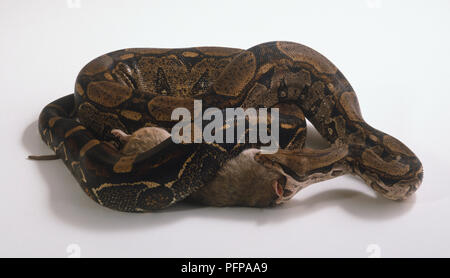
They wondered why the carcass of such a rare animal would be trashed rather than sent to a research facility. IBAMA agents questioned the zoo's administrator, Giselda Candiotto, who said she'd taken the boa home and that it had died. Their inspection also revealed that three-quarters of the zoo's 635 animals had disappeared, among them the white boa. In 2011 Brazil's National Environment Agency (IBAMA) closed the Niterói Zoo for mistreatment of animals. Prices ranged from $12,500 to $25,000-ten to a hundred times higher than for other boas-reflecting the commercial value of snakes with the potential to have entirely white offspring.

In 2011 he began offering Princess Diamond snakes for sale. Stone's initial attempts were unsuccessful, but by 2010 he'd produced a handful of babies. Over generations, if both parents have the recessive trait and pass it on, that trait will appear in their offspring. When a snake with a recessive gene, like leucism, is paired with a normal one, the resulting offspring will be heterozygous (or het), meaning that it won't exhibit the trait but will carry the gene for it. "I'm trying to find the rarer, the funner, the coolest looking," Stone said in an Internet radio interview. He called it his Princess Diamond project.īreeding snakes to produce unusual color combinations is popular. In 2009 Stone set out to breed a similar leucistic boa. "This was the most amazing Boa Constrictor I have ever laid my eyes on, and we quietly worked out negotiations to obtain the animal." "I got a Special Call from a friend," he later wrote on his website. Brazilian law allows exportation of a wild-caught snake only with a permit, and obtaining a permit for this particular boa seemed to be a pipe dream. He wanted to buy the snake and take it back to the United States for breeding, but he knew he'd never be able to do so-at least not legally. One American snake breeder, Jeremy Stone, was captivated and visited Brazil to see the "boa holy grail." Shortly afterward, a YouTube video announced the find to the world.Īs the only one of its kind, the white boa was coveted in the reptile trade for its ability to propagate uniquely colored descendants, or "morph" snakes.Īlmost as soon as the video was posted, collectors in online forums expressed their desire for the snake's progeny, with specialists valuing the rare specimen at $350,000 to $1 million. Because the white color would attract predators, its chances of surviving in the wild were slim.Īuthorities brought the snake to the Niterói Zoo, a private foundation that rescued and rehabilitated injured wild animals. The young boa appeared white, but it had dark eyes.

Leucism is a condition in which pigmentation is reduced but not entirely absent, as in albinism. It was the world's first known-and remains the only known-wild leucistic specimen of Boa constrictor constrictor, better known as the red-tailed boa. In 2006 firefighters in the Niterói district of Rio de Janeiro stumbled across a boa constrictor.

But that's changing, thanks to a group of dedicated investigators who are pursuing smugglers to the ends of their jurisdiction and beyond. With its abundant rare species and remote locales, Brazil has long been known as an epicenter for wildlife trafficking.


 0 kommentar(er)
0 kommentar(er)
